If you're a homeowner, knowing about asbestos and its safe removal is critical for a healthy living space. Asbestos can be found in homes, especially those built before the 1980s, posing serious health risks like lung cancer and asbestosis. Identifying asbestos is significant, whether in attics, walls, or flooring, so consulting certified professionals for assessment and removal is fundamental. The removal process involves containment, safe disposal, and adhering to legal regulations. After removal, it's important to conduct inspections to guarantee no remnants remain. To further protect your home, you can learn effective strategies for ongoing safety and prevention.
Understanding Asbestos and Its Risks
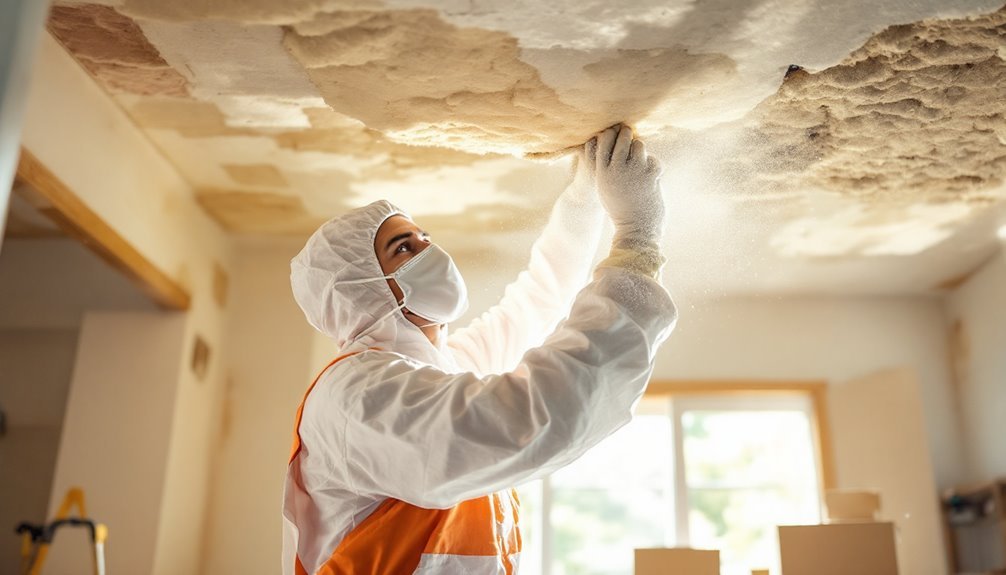
Asbestos is often present in homes built before the 1980s, and understanding its risks is vital for homeowners. You should know that asbestos comprises several types, including chrysotile, amosite, and crocidolite, each posing different levels of danger. Prolonged exposure to asbestos fibers can lead to serious health issues, such as asbestosis, lung cancer, and mesothelioma. Being informed about these risks empowers you to make better decisions regarding your home.
Legal regulations surrounding asbestos management vary by location but typically require homeowners to handle any asbestos-related issues with caution. Many jurisdictions mandate that you notify local authorities before undertaking any renovation or demolition work that might disturb asbestos-containing materials. Failure to comply with these regulations can lead to severe penalties, and more significantly, it can jeopardize your health and that of your family.
To guarantee a safe living environment, it's imperative to assess your home for asbestos and understand your legal responsibilities. If you suspect the presence of asbestos, consider consulting a licensed professional for testing and advice on safe removal. Your proactive approach can help preserve your freedom to live in a safe and healthy home.
Common Locations for Asbestos
Identifying where asbestos might be lurking in your home is a vital step in managing its risks. Many homeowners often overlook common areas where asbestos can be found. One primary location is in the attic and walls, where asbestos insulation is frequently used to improve energy efficiency and fire resistance. If your home was built before the 1980s, you might find this type of insulation in these spaces.
Another common location is the flooring. Asbestos tiles, often used in older homes for their durability and aesthetic appeal, can pose a significant risk if damaged. If you notice any cracks or wear in these tiles, it's important to address the issue promptly.
Furthermore, check around heating systems, including furnaces and pipes, where asbestos insulation may have been applied for safety. You should likewise examine ceilings, particularly in older homes where textured finishes, like popcorn ceilings, may contain asbestos.
Signs of Asbestos in Your Home
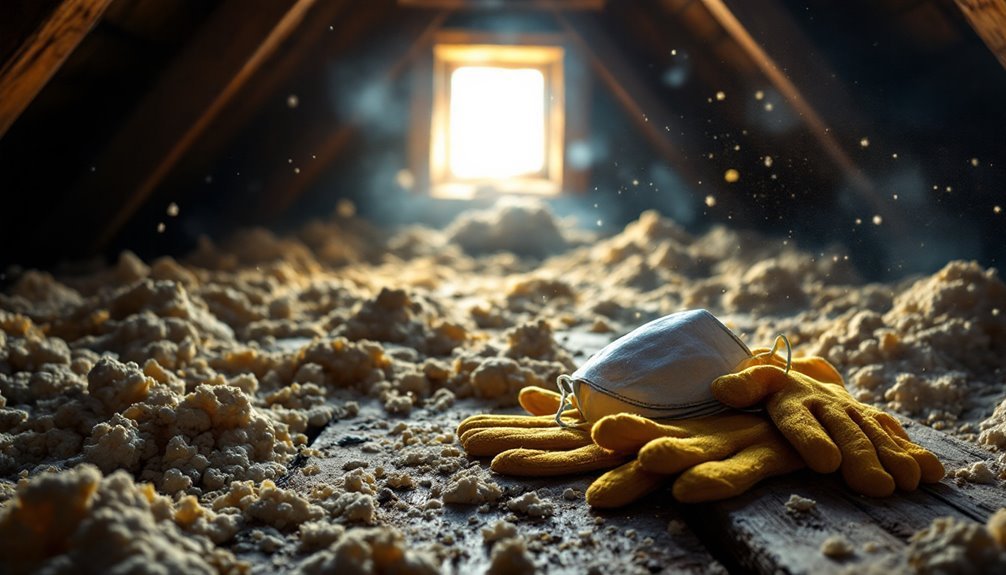
Many homeowners may not realize the subtle signs that indicate the presence of asbestos in their homes. Recognizing these signs is essential for ensuring your safety and that of your family. Start by examining areas like ceilings, walls, and floors, especially if your home was built before the 1980s. Common materials that often contain asbestos include popcorn ceilings, vinyl floor tiles, and insulation.
If you notice any damage, such as frayed insulation or crumbling materials, it's a clear signal to investigate further. Asbestos detection methods can include visual inspections and sampling, but it's best left to professionals who can accurately identify asbestos materials. Look for suspicious textures or materials that seem out of place; they could be indicators of asbestos presence.
You might likewise consider the age of your home when identifying potential risks. If you suspect any materials might contain asbestos, don't disturb them yourself. Instead, consult with certified asbestos removal experts who can perform thorough assessments and determine the safest course of action. By being vigilant and proactive, you can help create a safer living environment for you and your loved ones.
Health Effects of Asbestos Exposure
Asbestos exposure poses serious risks to your respiratory health, increasing the likelihood of conditions like asbestosis and lung cancer. Even short-term exposure can lead to long-term health consequences that may not surface until years later. Understanding these risks is vital for protecting yourself and your loved ones from the dangers associated with asbestos in your home.
Respiratory Illness Risks
Exposure to asbestos fibers can lead to a range of serious respiratory illnesses, making it vital for homeowners to understand these risks. When asbestos-containing materials deteriorate or are disturbed, they release fibers into the air, which can be inhaled. This poses a direct threat to your respiratory health, potentially leading to conditions such as asbestosis, lung cancer, and mesothelioma.
To mitigate these risks, you need to prioritize indoor air quality and guarantee effective respiratory protection. If you suspect the presence of asbestos in your home, it's imperative to avoid disturbing it. Instead, consult with certified professionals who can safely assess and remove asbestos materials. They have the expertise to manage the situation without compromising your health.
Additionally, maintaining good ventilation and using air purifiers can help improve indoor air quality during and after the removal process. Remember, the health of you and your family should always come first. By understanding the dangers of asbestos exposure and taking the necessary precautions, you can create a safer, healthier living environment free from the risks associated with respiratory illnesses related to asbestos.
Long-term Health Consequences
When inhaled over time, asbestos fibers can lead to severe long-term health consequences that manifest years or even decades after initial exposure. The risks associated with long-term exposure to asbestos are considerable, with notable increases in cancer risk being a primary concern. You should be aware of the following health issues linked to asbestos exposure:
- Asbestosis: This chronic lung disease results from the accumulation of asbestos fibers in lung tissue, leading to scarring and respiratory problems.
- Lung Cancer: Individuals with a history of asbestos exposure face a heightened risk of developing lung cancer, especially if they smoke.
- Mesothelioma: This rare and aggressive cancer primarily affects the lining of the lungs and abdomen and is directly tied to asbestos exposure.
Understanding these long-term health consequences is crucial for maintaining a safe and healthy living environment. If you suspect asbestos in your home, taking proactive measures for its removal can greatly reduce your cancer risk and other serious health conditions. Remember, knowledge is power, and safeguarding your health begins with educated choices about asbestos.
Importance of Professional Assessment
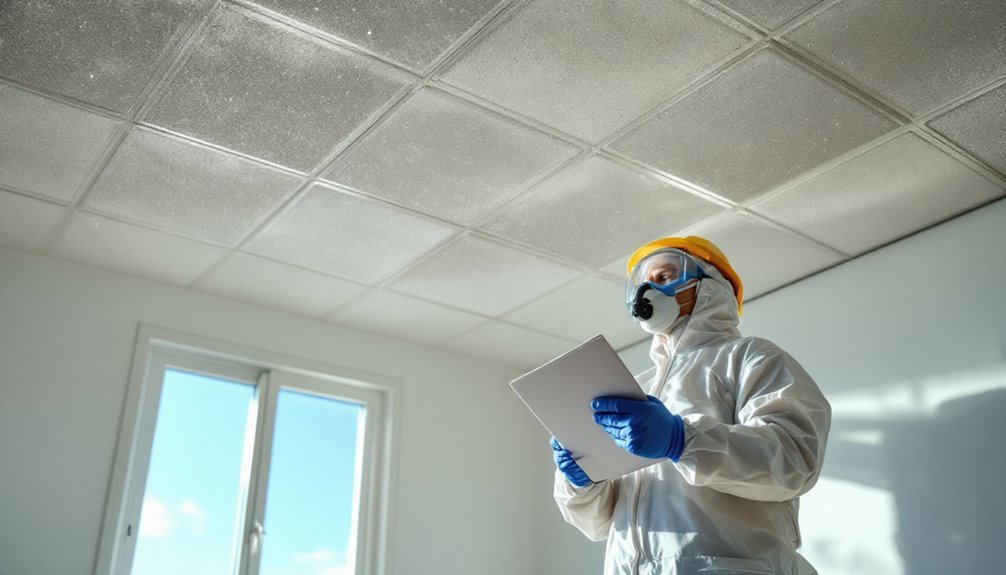
When it comes to asbestos removal, a professional assessment is essential for identifying health risks associated with exposure. Experts can accurately determine the presence and condition of asbestos materials, ensuring you comply with local regulations. Without this assessment, you might unknowingly put yourself and others at risk.
Health Risks Identification
Identifying health risks associated with asbestos in your home is crucial for ensuring your safety and well-being. Asbestos exposure can lead to serious health issues, including lung cancer and mesothelioma. That's why professional assessment and asbestos testing are significant steps in managing your living environment. By understanding the potential hazards, you can take informed action to prevent exposure.
Here are three key reasons why a professional assessment is crucial:
- Expert Analysis: Trained professionals can accurately identify the presence and condition of asbestos-containing materials, ensuring you receive reliable information.
- Safety Protocols: Professionals follow strict safety guidelines during testing and removal, minimizing your risk of exposure and ensuring a safer home environment.
- Comprehensive Solutions: A thorough assessment helps you develop a tailored plan for asbestos removal or containment, focusing on exposure prevention that suits your specific needs.
Ultimately, by prioritizing professional assessment, you're not just protecting yourself; you're safeguarding your family's health and well-being. Make the right choice for a safe living environment today.
Compliance With Regulations
Understanding the health risks associated with asbestos isn't the only reason to seek professional assessment; adherence to regulations is just as pivotal. When it comes to asbestos removal, following regulatory compliance isn't merely a suggestion—it's a legal obligation. Failing to follow these regulations can lead to severe penalties, including fines and legal action, which could jeopardize your freedom and financial stability.
Professionals in asbestos assessment are well-versed in the complex web of local, state, and federal regulations that govern asbestos handling and removal. They can navigate these legal obligations effectively, guaranteeing that your project meets all necessary guidelines. By hiring experts, you not only safeguard your home but likewise protect yourself from potential legal ramifications.
Furthermore, proper documentation and reporting are often required during the removal process. Professionals verify that everything is recorded accurately, providing you peace of mind that you've fulfilled your responsibilities as a homeowner. Remember, compliance isn't just about following rules; it's about creating a safe and healthy environment, both for you and for future occupants. So, don't compromise on professional assessment—it's crucial for your legal compliance and overall well-being.
The Asbestos Removal Process
The asbestos removal process is a vital procedure that demands careful planning and execution to guarantee safety. You need to understand that improper handling can lead to serious health risks. Here's a concise breakdown of the key steps involved:
- Assessment: Before starting, a certified professional should evaluate the extent of asbestos in your home. This assessment determines the appropriate removal techniques.
- Containment: Once you've identified the areas affected, it's imperative to seal them off. This minimizes the spread of asbestos fibers during the removal process.
- Removal and Disposal: Professional contractors will employ specialized removal techniques to safely extract the asbestos. Following removal, proper disposal methods are critical to prevent environmental contamination.
Safety Precautions During Removal
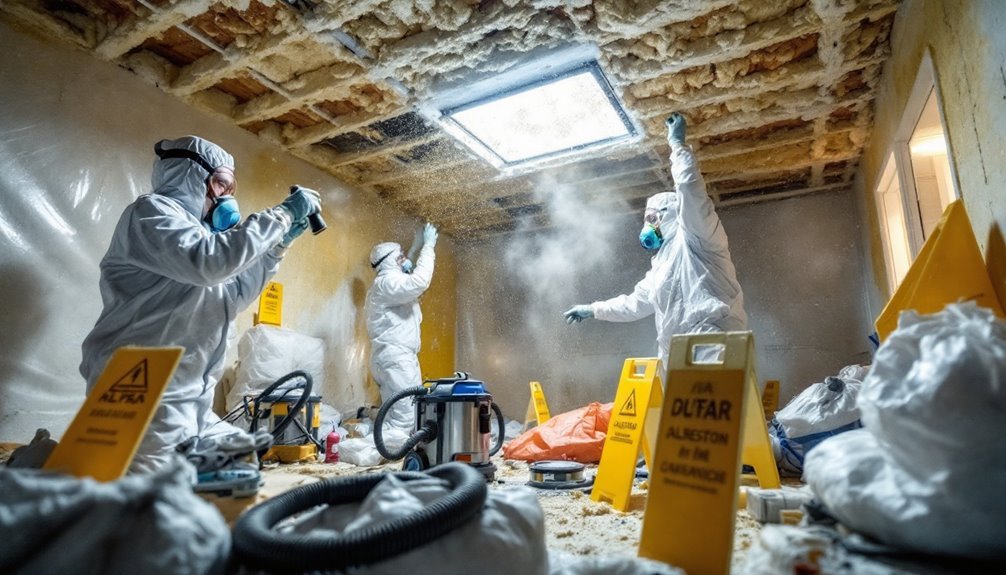
After confirming that the asbestos removal process is properly planned and executed, prioritizing safety precautions is fundamental to protect both workers and residents. First and foremost, you must utilize personal protective equipment (PPE) to minimize exposure risks. This includes disposable coveralls, gloves, and respirators specifically designed for asbestos handling. Confirming that all personnel are trained in proper PPE usage is pivotal.
Next, implementing air quality monitoring is critical throughout the removal process. Regular checks help detect any airborne asbestos fibers, allowing immediate action if levels exceed safety thresholds. You should establish clear protocols for air sampling and testing, confirming that results are readily available and understood by everyone involved.
Moreover, you must secure the work area to prevent unauthorized access, particularly for children and pets. Using barriers and signage not only protects those outside the work zone but additionally reinforces the seriousness of the operation.
Finally, maintain open communication with residents about the removal process and safety measures being taken. This transparency nurtures trust and reinforces the shared commitment to a safe, healthy living environment. Prioritizing these safety precautions confirms a smoother, more secure asbestos removal experience.
Post-Removal Inspection and Testing
Once asbestos removal is complete, verifying thorough inspection and testing is essential to confirm that the area is safe for reoccupation. Following specific post removal guidelines helps you avoid future health risks. Here's what you should prioritize during the inspection procedures:
- Visual Inspection: Examine the site for any visible remnants of asbestos or dust. Look for areas that might have been overlooked during the removal process.
- Air Quality Testing: Conduct air sampling to measure asbestos fiber levels. This testing should be performed by a certified professional to guarantee accuracy and reliability.
- Surface Testing: Collect samples from surfaces in the area. This will help identify any potential contamination that could pose a risk to you and your family.
Preventing Future Asbestos Issues
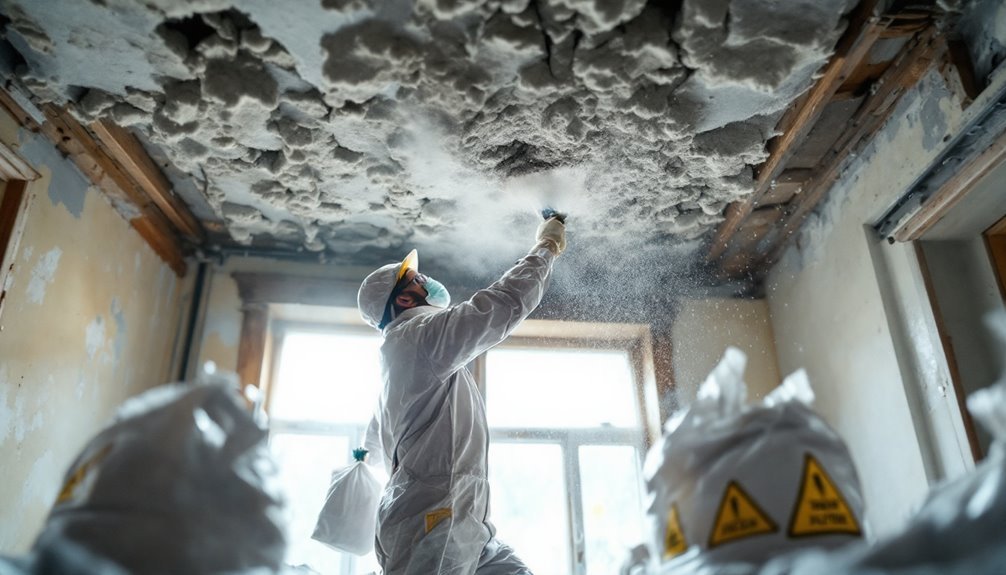
How can you guarantee that your home remains free from future asbestos issues? First, stay informed about the materials in your home. Regularly inspect areas like attics, basements, and around pipes where asbestos might be present. If you're unsure, consider hiring a professional for an assessment.
Implementing asbestos maintenance tips is essential. If you identify any damaged asbestos materials, address them promptly by contacting qualified professionals. Avoid DIY methods, as they can inadvertently release harmful fibers into the air.
In addition, incorporate future prevention strategies. Verify proper ventilation in your home, as this helps reduce asbestos exposure risk. When renovating or making repairs, always check for potential asbestos-containing materials first.
Educate yourself and your family about the dangers of asbestos. Awareness can empower you to act quickly if you suspect any issues. Finally, maintain a clean living environment. Regularly clean and dust your home, as this can help minimize the accumulation of hazardous particles. By staying vigilant and proactive, you'll greatly decrease the likelihood of facing asbestos-related problems in the future. Your home can remain a safe haven with the right precautions in place.
Conclusion
In tackling asbestos removal, you're not just safeguarding your home; you're protecting your health and that of your loved ones. While the presence of asbestos can seem intimidating, understanding its risks empowers you to take action. By opting for professional help, you guarantee a thorough and safe removal process, transforming a potential hazard into a secure sanctuary. Remember, the effort you invest today can lead to a healthier, more vibrant living environment tomorrow. Don't wait—act now.
